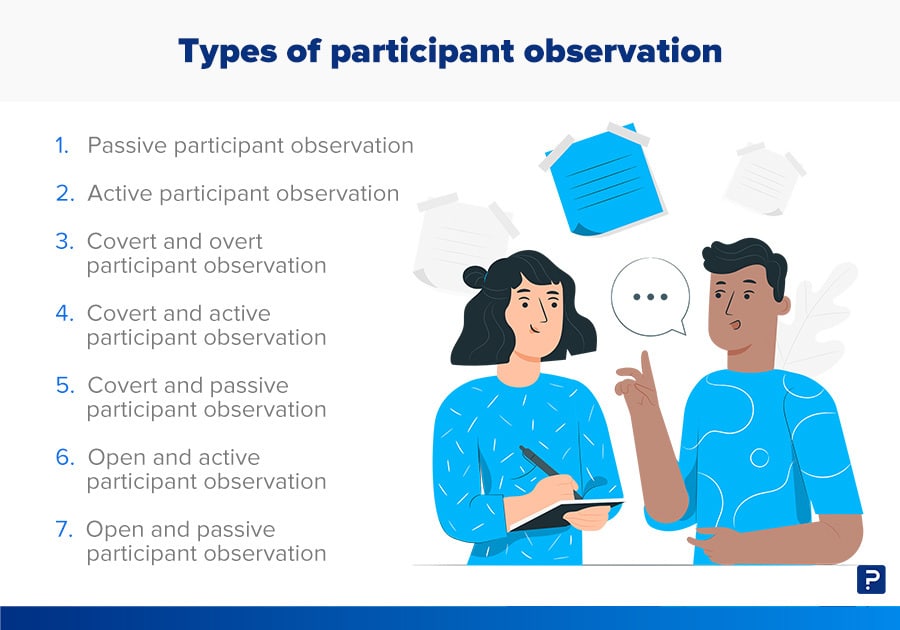
Participant observation is a powerful research method often used in fields like anthropology, sociology, and psychology. It allows researchers to study people in their natural environment by actively participating in it rather than just observing from the sidelines. This approach offers a unique view into everyday life, customs, and behaviors that might not be apparent through other methods.
In this blog, we’ll explore what participant observation is, the different types, and how it’s used.
What is Participant Observation?
Participant observation is a qualitative research methodology in which the researcher studies a group not only through observation but also by participating in its activities.
In this qualitative observation methodology, the researcher immerses himself in the daily activities of the participants in order to record the behavior in as many scenarios as possible.
Thanks to the immersion in the study place, the researchers can observe the daily life of the people: their exchanges with each other, their formal and informal conversations, habits, etc.
It offers observers the opportunity to collect honest and intimate information about people. However, this information is filtered through the perspective of researchers who, by using this method, run the risk of losing their objectivity and altering with their presence the behavior of the groups they study.
Importance of Participant Observation
The main advantage of participant observation is that it allows researchers to step into someone else’s world. By joining a group, researchers get a richer, more complete understanding of the group’s routines, values, and even challenges. Here’s a closer look at why it matters:
Capturing Real-Life Details
Life is full of small details that might not come up in a survey or interview. Participant observation lets researchers see these details first-hand. For example, they might notice how a team communicates during a meeting or how family members interact during a cultural celebration.
Building Trust and Gaining Honest Insights
When researchers take part in a group’s daily life, they can build trust with the people they’re studying. This can lead to more honest, open interactions. People tend to act more naturally when they feel comfortable and aren’t just being watched from afar. This trust is important for understanding real behaviors and attitudes, especially in sensitive settings like healthcare or social work.
Learning Unspoken Norms and Routines
Every group has its own unspoken “rules” and habits. These could be daily routines, ways of interacting, or even gestures that are unique to the group. By being involved, researchers get to experience these norms themselves, which is important for an in-depth understanding of the context of certain behaviors.
Flexible Approach for Gathering Information
Participant observation is also flexible, allowing researchers to adapt as they go. If they notice something interesting or unexpected, they can choose to spend more time exploring it.
Characteristics of participant observation
Participant observation has historically been associated with a form of field research in which the researcher resides for long periods of time in a small community.
Today, this methodology is used in a wide variety of settings and for widely varying periods of time, from a single interaction to many years. But it is usually characterized by the following points:
- The long-term nature of the interaction between the researcher and the participants is part of the fieldwork process.
- A wide range of relationship dynamics that it studies, such as differences in status between the two parties, differences in power and educational differences, as well as degrees of formality. Differences in power can have their origin in gender, social class, health and other aspects.
- There is a variety of settings, from close interpersonal interactions to observing public gatherings and actual participation in social events.
- In many cases, research takes place in settings unfamiliar to the researcher, which will make her presentation and interaction with others especially sensitive.
- There may be different ethical codes between the groups studied and those of the researcher’s country or institution of origin. They may also differ from the ethical principles followed by the host government, non-governmental organizations in the area, or agencies funding the research.
- The changing nature of the researcher’s roles and relationships with the studied group over time.
- The use of technology to document observations, including mapping, photography, and video and audio recording.
What are the pros and cons of participant observation?
Here are some plain-world pros and cons of participant observation.
Pros of Participant Observation
In-Depth Understanding
Since researchers are right in the middle of the action, they can gain a deep understanding of behaviors, relationships, and cultural practices. This first-hand experience allows them to see things that might be difficult to capture in surveys or interviews.
Ability to Build Trust
By being present and engaged, researchers can build rapport with participants. This trust can encourage people to share their thoughts and experiences more openly.
Flexible Research Process
Participant observation allows for flexibility. If something unexpected comes up, researchers can explore it in real time, rather than being restricted to a strict questionnaire or rigid study structure.
Cons of Participant Observation
Time-Consuming
This method often requires a lot of time. Researchers may need to spend months or even years in a setting to truly understand what’s going on.
Subjectivity and Bias
Since the researcher is directly involved, their personal experiences and perspectives can influence what they observe. It can be tricky to remain objective when you’re part of the group, so bias is a risk.
Difficulty in Taking Notes
When you’re fully immersed in activities, taking notes on what you observe can be challenging. Important details might slip away, especially if the researcher has to recall everything afterward.
Not Always Easy to Apply to Other Groups
Because participant observation is so focused on a specific group, the findings may only really make sense for that one setting. So, if researchers want to apply what they’ve learned to a larger population, it’s not always possible.
Types of Participant Observation
Now that you know what this method is and what its most common characteristics are, we will introduce you to the types that exist.

Passive Participant Observation
Researchers observe and record the behaviors of their subjects in their own environment without conversing or interacting with them in any way.
Many of the studies that use this form of participant observation are studies in which researchers observe people’s behavior and communications in public places, such as restaurants, coffee shops, transportation hubs, and even on the Internet, through innovative research methods such as netnography.
Active Participant Observations
Active participant observation involves researchers converse with their subjects and participate in the daily life of the groups they study, including their activities, customs, rituals, routines, etc.
The degree of commitment of researchers to these groups varies. Some researchers limit their interactions to interviews, while others engage in all aspects of their subjects’ lives.
Examples of this form of participant observation are studies in which researchers lived for long periods of time among different ethnic, cultural, or religious communities.
Covert and Overt
In covert participant observation, researchers do not make their presence known to their subjects, and if they do, they do not identify themselves as investigators, whereas in open participant observation, they do.
However, even when the investigation is open, investigators often do not inform the people they meet in the course of their investigation of the specific purpose of the investigation, nor do they inform everyone they meet that they are researchers, as this could unnecessarily interrupt conversations and events being observed.
Covert and Active
Covert and active participant observation have several advantages. In this type of participant observation, researchers can have access to a group that they would not otherwise have the opportunity to observe, and they can experience the practices of the group as they are experienced by the members of the group.
Generally, researchers can alter group behavior by their presence, but in this form of participant observation, groups would not consciously change their behavior in response to the researcher’s presence because they are not aware of being observed.
Covert and Passive
In the case of covert and passive participant observation, researchers are not likely to alter the behaviors of their subjects, since the researchers do not actively engage with their subjects and because the subjects are also not aware that they are being observed.
However, since observation is passive, researchers do not have the opportunity to experience the lives of their subjects for themselves.
Open and Active
If observation is open and active, people can participate in and experience their subjects’ activities as their subjects would, but they run the risk of both changing the behavior of their subjects through their interactions with them, and that their subjects change their behavior by themselves knowing that they are being studied.
Open and Passive
As in the case of covert and passive participant observation, researchers do not run the risk that their presence alters the behavior of the groups they study through their interactions with them.
However, the guinea pig effect is a problem for this form of observation, unlike the case of covert and passive participant observation, because the participants are aware that they are being studied. Furthermore, researchers cannot experience the world as it is as subjects would.
Conclusion
Participant observation is a unique and powerful research method that gives researchers a personal view of people’s lives, routines, and interactions. By actively engaging with the group they’re studying, researchers can capture valuable insights that would be hard to obtain from a distance.
This method reminds us of the importance of seeing life from others’ perspectives, showing that sometimes the best way to understand people is simply to walk a mile in their shoes.
So, uncover the insights that matter the most. Use QuestionPro’s market research platform to uncover complex insights that can propel your business to the forefront of your industry.
Frequently Asked Questions (FAQs)
Participant observation allows researchers to understand a group’s culture, social dynamics, and routines in a natural setting. This approach provides richer, more authentic insights, capturing details and nuances that other methods might miss.
Participant observation is commonly used in fields like anthropology, sociology, education, healthcare, social work, and workplace studies. It helps researchers understand cultural practices, social interactions, team dynamics, and much more.
In regular observation, the researcher remains a detached, outside observer without participating in the group’s activities. In participant observation, however, the researcher actively engages with the group, often immersing themselves in daily routines, allowing them to gain an “insider” perspective.







